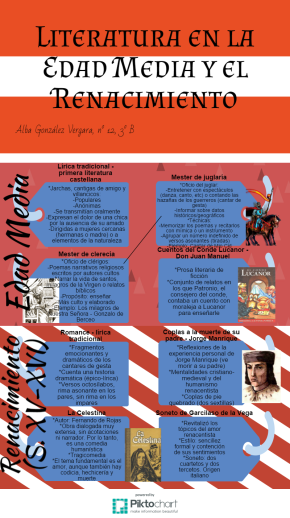El equipo de InfoEDUgrafías da las gracias por este bonita presentación un gran trabajo realizado por el alumnado de Chiclayo en Perú y nuestro mayor reconocimiento para ALeyda y su alumnado.
Mi nombre es Aleyda Leyva Cévez y escribo desde Chiclayo, una ciudad del norte de Perú. Hoy vi los resultados, ¡muchas felicidades por su peonza!
Hace un tiempo vengo trabajando infografías con mis chicos de secundaria (entre 12 y 15 años) y ha dado magníficos resultados. En esta oportunidad me gustaría compartir las infografIas realizadas en el tercer año de secundaria en donde abordamos el inicio de la Edad Moderna.
Datos claves
País: Perú
Institución Educativa Privada: Peruano Español (Sede Chiclayo)
Docente: Aleyda A. Leyva Chévez
INFOGRAFÍAS DE LA EDAD MODERNA EN POWER POINT
Tercer año entró a
la edad moderna y como proyecto de unidad decidimos trabajar infografías
ya que así tendrían oportunidad de indagar, organizar y representar
información, además que me aseguraría que sus productos sean originales.
Primero
definimos los hechos históricos referentes a los siglos XVI y XVII que se
debían investigar para que luego los chicos se encarguen de analizar el hecho
identificando, causas y consecuencias y; luego, sea plasmado en una infografía.
Estudiar dos
siglos en corto tiempo es un reto para los alumnos y docentes, en especial
cuando refiere a pueblos distantes cuya geografía política es difícil
reconocer, por eso con este proyecto se busca fomentar la investigación
de hechos específicos.
¿Cómo
trabajamos?
Ya que requería de una guía sencilla y que explicara el proceso de hacer
infografías para el curso de historia, decidí elaborar mi propia guía que quedó
organizada en cuatro pasos:
PASO 1:
Búsqueda de la
Información: A cada microequipo se le asignó un tema
específico sobre el tema de la unidad. En clase se da el alcance sobre las
principales características de cada aspecto, pero los alumnos deben investigar
datos más profundos.
PASO 2
Selección y
organización de la información: Los alumnos deben
identificar cuál es el contenido que deben incluir en su infografía, para esto se
plantea una serie de preguntas que le guíen en la organización de la
información, así verifican que su investigación de fuentes permite el estudio
del tema trabajar.
Las preguntas
planteadas deben girar en torno al tema indicado y a los siguientes ejes:
- ¿En
qué contexto se dio? (espacio y tiempo)
- ¿Qué
características presenta?
- ¿Cuáles
son sus elementos, clases o componentes?
- ¿Cuál
es la secuencia de hechos?
- ¿Qué grupos sociales y personajes
intervienen?
La idea es que cada
pregunta represente un tema a tratar en la infografía, así al responder
tendrá el contenido de la infografía organizado.
PASO 3
Diseño de la
infografía: Para esto los alumnos consultaron
este enlace para ver una guía para
reconocer los elementos y diferentes diseños. Visitan ejemplos de infografías
para luego identificar los organizadores visuales y las imágenes que permitirán
explicar mejor el contenido.
Para
identificar los organizadores visuales recomendados pueden verificar la
inserción de SmartArt en Power Point, pues es la plataforma que se empleará
para la realización de las infografías.
Debe identificar
los elementos (imágenes, texto, organizadores gráficos) con los que explicará
cada parte del contenido a presentar.
Definen un
título sugerente que motive la lectura de su infografía,
redactan la introducción del contenido y señalan las fuentes empleadas.
Los alumnos
arman su bosquejo en borrador, y compilan el material (imágenes, textos en
Word, etc.) en una carpeta zip.
PASO 4
Realización de
la infografía en Power Point: Power Point es sencillo
de usar y los alumnos ya reconocen su manejo, además soluciona la dificultad de
acceso a internet que tenemos en el colegio y en las viviendas de los chicos.
Estoy adjuntando el resumen en la experiencia y algunas de las infografías realizadas. Gracias por promover la metodología de aprendizaje Maker.
Valoración del
Proyecto
Ha sido una
experiencia enriquecedora en donde los estudiantes asumieron el reto de
realizar productos originales; además,
de respetar los tiempos. También
mejoró el número de alumnos que cumplieron con la actividad, esta vez el 100%
presentó su infografía y casi todos en el tiempo establecido.
Saludos desde Perú.
Aleyda Leyva Chévez
Agradecemos a la profesora Aleyda y a todo su alumnado, este gran trabajo con el hemos aprendido y disfrutado muchísimo.










































